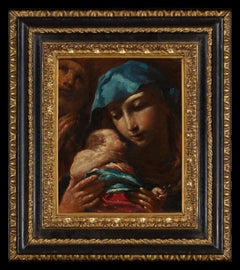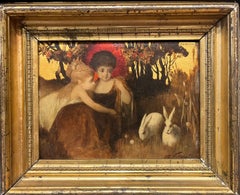Giuseppe Maria Crespi, called Lo Spagnuolo Art
to
1
1
1
1
Overall Height
to
Overall Width
to
1
1
1
1
1
1
1
6,958
3,340
2,513
1,213
1
1
1
1
Artist: Giuseppe Maria Crespi, called Lo Spagnuolo
Holy Family, by the bolgonese master.
By Giuseppe Maria Crespi, Lo Spagnuolo
Located in Brooklyn, NY
This exquisite painting, resembling a precious jewel, serves as an exceptional illustration of the
devotional cabinet paintings created by Giuseppe Maria Crespi, a highly original Bolognese
artist during the late 17th and early 18th centuries. Crespi's distinctiveness extended beyond his
unique style and technique to the subjects he chose to portray. While his portraits and genre
paintings often displayed a light-hearted and even irreverent tone, his treatment of religious
themes resonated with deep emotion, even in its most inventive forms.
This recently uncovered work by Crespi is a typical representation, invoking the tender
connection between mother and child, and the Child's destiny, all within a compact and intimate
format. Executed on a small scale, the painting showcases Crespi's remarkable sensitivity and
mastery of paint, especially evident in the expressive brushwork of the drapery.
The restrained and focused composition of the Holy Family allows for contemplation of the
figures. Mary cradles the Christ child gently, seemingly presenting him to the viewer, her gaze
knowing as the infant holds a diminutive cross, symbolizing his future crucifixion. Joseph
appears in the background, emerging from the left side of the frame, gazing upward with folded
hands in prayer.
Individual motifs from this painting reappear in other works by Crespi, suggesting a synthesis of
familiar elements into a vibrant composition. The artist's revisitation of designs throughout his
career is evident, and this painting on copper likely belongs to a later period, reflecting stylistic
ties to other works and Crespi's increased production of smaller devotional pieces.
Distinguished by its cool palette, bold coloration, and the expressive force of the artist's hand,
this Holy Family painting...
Category
Early 1700s Baroque Giuseppe Maria Crespi, called Lo Spagnuolo Art
Materials
Copper
Related Items
18th century oil sketches for a Baroque interior - a pair
Located in London, GB
A FEAST OF THE GODS WITH VENUS AND BACCHUS
Collections:
With Appleby Brothers, London, June 1957;
Hazlitt, Gooden & Fox, London, 1961;
John and Eileen Harris, acquired from the above, to 2015.
Literature:
Jacob Simon and Ellis Hillman, English Baroque Sketches: The Painted Interior in the Age of Thornhill, 1974, cat. no.12 (as by Louis Laguerre);
Elizabeth Einberg (ed.), Manners and Morals: Hogarth and British Painting, 1700-1760, exh. cat., London (Tate Gallery), 1987, cat. no.10 (as by Louis Laguerre);
Tabitha Barber and Tim Bachelor, British Baroque: Power and Illusion, exh. cat., London (Tate Britain), 2020.
Exhibited:
Twickenham, Marble Hill House, English Baroque Sketches: The Painted Interior in the Age of Thornhill, 1974, no.12 (as by Louis Laguerre);
London, Tate Gallery, Manners and Morals: Hogarth and British Painting, 1700-1760, 1987, no.10 (as by Louis Laguerre);
London, Tate Britain, British Baroque: Power and Illusion, cat. no 92, 2020.
CUPID AND PSYCHE BEFORE JUPITER
Collections:
With Appleby Brothers, London, June 1957;
Hazlitt, Gooden & Fox, London, 1961;
Anthony Hobson, acquired from the above, to 2015.
These recently re-united paintings are the most ambitious surviving baroque ceiling sketches made in Britain in the early eighteenth century. From the Restoration until the rise of Palladianism in the 1720s decorative history painting formed the preeminent artistic discipline in Britain. It was a field dominated by Continental artists including the Italian Antonio Verrio and the Frenchmen Louis Laguerre and Louis Chéron...
Category
Early 18th Century Baroque Giuseppe Maria Crespi, called Lo Spagnuolo Art
Materials
Oil, Canvas
Oil Portrait of Girls with Rabbits
Located in Fredericksburg, VA
Heinrich Faust is a German genre painter of the late 19th century. He painted dramatic interpretations of everyday occurrences such as families and grou...
Category
Late 19th Century Baroque Giuseppe Maria Crespi, called Lo Spagnuolo Art
Materials
Gold Leaf
Fenzoni, Painting AND preparatorial Drawing, John the Baptist, Italy Renaissance
By Ferrau Fenzoni
Located in Greven, DE
The painting and the preparatory drawing are offered together.
Provenance
Private collection, Germany, Trier, c. 1980- 2013
Saint John the Baptist
Brown ink and wash over red chalk on oatmeal paper
31 x 20.5 cm
Inscribed: „Ferrau Fenzonio da Faenza invt. esque … imp. da Fran. Villamena …“.
bears the collector's mark of Henry Scipio Reitlinger (1882-1950; Lugt 2274a) on a tiny label glued to the verso
On the reverse is a partial drawing of a Pieta, pricked for transfer.
Provenance
New York, Doyle, 14. October 2015, No. 6
The painting and the preparatory drawing resemble the composition of an engraving after Ferraù Fenzoni by Francesco Villamena. Drawing, engraving and painting are almost identical, except for minor differences. Even the measurements nearly correspond: painting (32 x 25,5 cm), drawing (30 x 20,5 cm), engraving (31,1 x 23,5 cm).
Dr. Guiseppe Scavizzi confirmed the attribution of the present panting to Fenzoni and he dates it to c. 1590.
The inscription on the drawing reads “Ferrau Fenzonio da Faenza invt. esque. . . imp. da Fran: Villamena . . .”. The engraving’s inscription also lists place and date “Ferra Fensionius inventor/F. Villamoena sculpsit Rome/Aspectu fruitur… antra puer/cum Privilegio… 1613”.
Interestingly, the engraving is not mirrored as it is in most printing processes. Painting, drawing and engraving are not reversed but the same. It is remarkable to note that there are further paintings by Fenzoni which were engraved in the same order and not reverted. They also show strong parallels regarding the compositions and the measurements (see for example “Deposition of Christ” ).
Ferraù Fenzoni was an Italian painter mainly active in Todi. He is also called Il Faenzone after his birthplace (Faenza). He apprenticed in Rome during the papacy of Gregory XIII and contributed to numerous fresco cycles under pope Sixtus V, such as the Loggia della Benedizioni in the Lateran Palace, the frescoes on the walls and vaults of the Scala Santa of the adjacent Basilica of San Giovanni in Laterano, and the decoration in the Sistine library. His expressive canvases straddle the styles of Mannerism and Baroque. In 1594, he moved to Todi. A “Last Judgement” by him is housed in the cathedral of Todi. He returned to Faenza in 1599, where he decorated chapels in the cathedral from 1612 to 1616. In 1622, he completed a “Deposition”, now in the local Pinacoteca. In 1640, Fenzoni was named “cavaliere dello speron d’oro” by Cardinal Colonna and, on 25th April 1634, he was nominated vicar and “castellano of Granarolo”.
Fenzoni‘s style is characterized by a mixture of the Mannerism of the Northern Netherlands and the Italian Baroque.
Saint John the Baptist, Old Master, 17th Century, By Fenzoni, Religious Scene, Rome Art...
Category
16th Century Mannerist Giuseppe Maria Crespi, called Lo Spagnuolo Art
Materials
Oil, Canvas, Handmade Paper
17th century Italian figure painting - Fall of Fetonte - Oil on copper Landscape
Located in Varmo, IT
Roman master (c. 1650) - The Fall of Phaeton.
40.5 x 52.5 cm without frame, 56.5 x 59.5 cm with frame.
Oil on copper, in carved and gilded wooden fra...
Category
Mid-17th Century Baroque Giuseppe Maria Crespi, called Lo Spagnuolo Art
Materials
Copper
Three Angels
By Domenico Piola the Elder
Located in New York, NY
Provenance:
Robert L. and Bertina Suida Manning, New York, until 1996
Private Collection, USA
One of the leading artists in Genoa during the second half of the seventeenth century, Domenico Piola came from a successful family of artists, renowned for their many illusionistic ceiling programs throughout Genoese churches and palaces. A prolific draughtsman and painter, Domenico oversaw an extremely productive studio. In addition to his collaborations with numerous other artists, Domenico also provided many designs for book illustrations and prints that circulated throughout Europe, earning him international exposure and high acclaim in his own day.
As Dr. Anna Orlando has indicated (written communication), the present work is an early work by Piola, datable from the late 1640s. At this time the young artist came strongly under the influence of Castiglione and Valerio Castello, while admiring the works of Giulio Cesare Procaccini. Piola’s works from this period are exuberant and fluid, and the artist’s love of portraying children is evident from the angels and putti that populate both his altarpieces and more intimate paintings.
The present work depicts three angels...
Category
17th Century Baroque Giuseppe Maria Crespi, called Lo Spagnuolo Art
Materials
Oil, Canvas
Madonna Addolorata By Sassoferrato
By Giovanni Battista Salvi da Sassoferrato
Located in New Orleans, LA
Sassoferrato (Giovanni Battista Salvi)
1609-1685 Italian
Madonna Addolorata
Oil on canvas
Celebrated Italian artist Sassoferrato and his moving religious imagery are the epitome ...
Category
17th Century Baroque Giuseppe Maria Crespi, called Lo Spagnuolo Art
Materials
Oil, Canvas
H 38.5 in W 32.38 in D 3.63 in
Joseph Holding the Christ Child
By Pietro Bardellino
Located in New York, NY
Provenance: Private Collection, Argentina.
A work of great delicacy and intimacy, this small painting on copper by Pietro Bardellino treats a subject which grew in popularity during the Baroque period: Saint Joseph and the Christ child...
Category
18th Century Baroque Giuseppe Maria Crespi, called Lo Spagnuolo Art
Materials
Copper
Large Oil On Canvas 'a nude Bacchante' After William Bouguereau (1825-1905)
Located in Gavere, BE
A fine copy after "Une Bacchante" by William Bouguereau (1825-1905), oil on canvas, 115 x 185 cm. The original of "Bacchante playing with a goat", dating from 1862, is now part of th...
Category
1880s Baroque Giuseppe Maria Crespi, called Lo Spagnuolo Art
Materials
Canvas, Oil
H 45.28 in W 72.84 in D 1.19 in
Oil On Canvas "The Goddess Artemis" 19th Century French school
Located in Gavere, BE
Henri-Camille Danger was a French Impressionist and Modern painter born in 1857. The artist died in 1937.
His work has been featured in an exhibition at the Museo Nacional de Arte, ...
Category
1890s Baroque Giuseppe Maria Crespi, called Lo Spagnuolo Art
Materials
Gold Leaf
Free Shipping
H 37.41 in W 37.41 in D 1.97 in
Dance
By Lorena Villalobos
Located in Los Angeles, CA
LORENA VILLALOBOS
"DANCE"
OIL ON CANVAS, SIGNED
COSTA RICA, DATED 2005
39 X 29 INCHES
Lorena Villalobos
Villalobos was born in Costa Rica in 1961.
She studied Fine Arts at t...
Category
Early 2000s Mannerist Giuseppe Maria Crespi, called Lo Spagnuolo Art
Materials
Canvas, Oil
French school rococo late 18th century oil on canvas The vestales
Located in PARIS, FR
French school of the late 18th century
Jerome PREUDHOMME (Attributed to) Arras, v1735 - Paris, 1810 Oil on canvas 47.5 x 55 cm (59 x 67 cm with the frame) Beautiful old carved woode...
Category
Late 18th Century Baroque Giuseppe Maria Crespi, called Lo Spagnuolo Art
Materials
Oil
oil on canvas Historical Scene " The Surrender of Breda "after Diego Velasquez
Located in Gavere, BE
The Surrender of Breda, June 5, 1625, known as the Lances is an oil on canvas painted by the Spanish painter Diego Velázquez (1599, Seville - 1660, Madrid) during the years 1634-1635...
Category
1890s Baroque Giuseppe Maria Crespi, called Lo Spagnuolo Art
Materials
Gold Leaf
H 32.29 in W 40.95 in D 1.58 in
Giuseppe Maria Crespi Lo Spagnuolo art for sale on 1stDibs.
Find a wide variety of authentic Giuseppe Maria Crespi Lo Spagnuolo art available for sale on 1stDibs.


